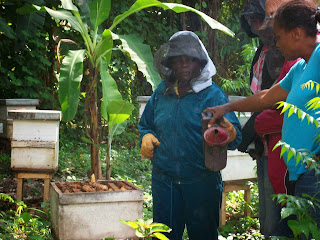When fruit and other permanent crops are a large part of the farm income, the hillsides can remain protected by vegetation, and the rivers can continue to run clear.
ROPAGA (the Network of Peasants Organizations of Grand Anse) is working to encourage greater utilization and productivity of fruit trees, and they hosted us for a tour of their fruit tree nurseries.
They are also working with several other forest products, including honey. They have members of their organization who construct the hives (supers), and at the time of one of the pre-conference visits were fulfilling a contract for a quantity at 2000 gdes per box (roughly $50 US dollars).
The use of the rectangular boxes instead of a simpler top-bar hive or the traditional hollow log allows the beekeeper to keep the queen and the baby bee larvae separated from the honey-filled comb. Then at harvest time, the comb can be taken without diminishing the population of the bees. In addition, the frames can be spun in a centrifuge, allowing the bees to start filling the comb again without having to expend the energy to rebuild the comb first.

The honey in a top-bar hive and a hollow log cannot be harvested without destroying the comb and at least a few bees.
The beekeepers showed how to protect against stings by covering skin and hair with gloves, long sleees, and a mesh face shield over a hat while using smoke to keep the bees focused on the honey instead of attacking the intruders.
A highlight of the day was seeing a master tree climber use two ropes to bring himself quickly to the top of a palm tree. He used one loop to support his left thigh and used the other loop to make a step for his right foot. He then balanced on one side at a time while he raised or lowered the opposite loop. Dr. Paul also gave the method a try.
The next stop for the field trip was a private farm near Gebaud. The farmer wanted to showcase the contrast between the land where he had been practicing multi-story agriculture and an adjoining parcel where he cleared the land to plant vegetables.
At the same time, we saw a section of land closer to the river which had been planted with vegetables and bananas, but which was completely washed away by Hurricane Sandy, which had come through the area the weekend before.
The final stop was the city center. The Catholic Church on the plaza overlooks a statue commemorating "les Trois Dumas," the three generations of Dumas writers with their heritage in Jeremie, including Alexandre Dumas, author of "The Three Musketeers".
No trip to Jeremie is complete without komparet, the local specialty sweet bread with cinnamon, ginger, coconut, and a few raisins for decoration. This shop is just up the hill from the main square, and everyone enjoyed a fresh-baked snack.
The final stop before the end of the day was to see the shop where Caritas markets some of their "transformed products" like jelly, cocoa, cremas, and roasted peanuts. These are produced by women's cooperatives in various local parishes around the region, and Caritas supports them with training, recipes and packaging materials.







No comments:
Post a Comment